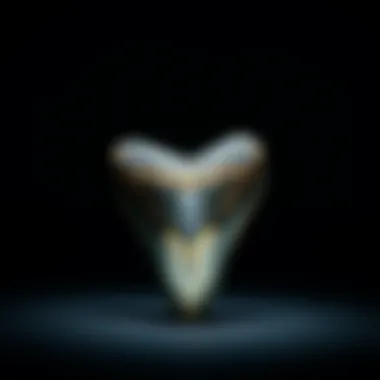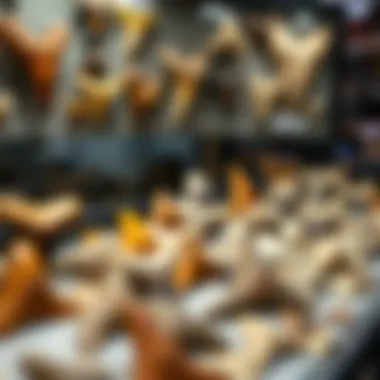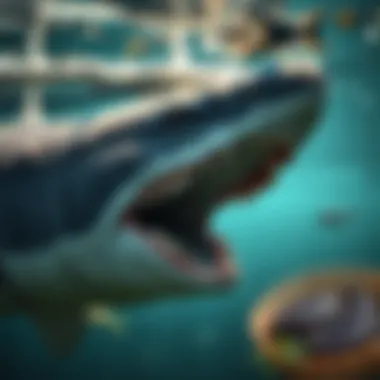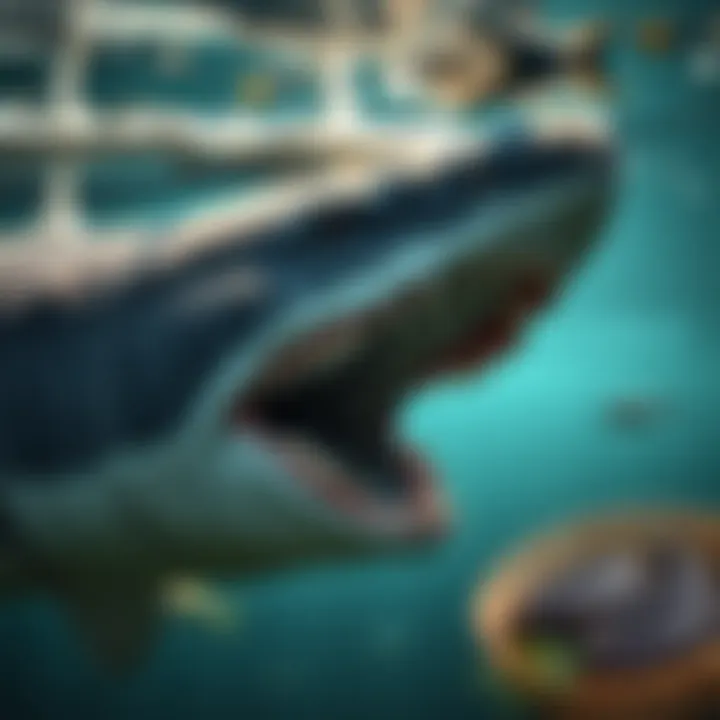The Intriguing Aspects of 5-Inch Megalodon Teeth


Intro
In the vast expanse of our planet's history, few creatures ignite the imagination quite like the megalodon. With teeth that can measure up to 5 inches, these ancient sharks were the apex predators of their time. The significance of megalodon teeth goes beyond their formidable size; these dental relics capture a story of life, survival, and evolution that extends back millions of years. For enthusiasts and collectors, the allure of these fossils is immense not just because of their dramatic size, but also due to the historical and ecological context they embody.
As we plunge into the intricate world of 5-inch megalodon teeth, it's important to highlight key aspects that make these fossils worthy of exploration. We will dive into their rich history and origins, scrutinize the characteristics that lend them uniqueness, and discuss how one can verify the authenticity of such specimens. Furthermore, ethical collecting practices will also be an essential part of the conversation, ensuring that we appreciate these treasures while respecting nature and its laws.
Buckle up for an enlightening journey through time, as we decode what megalodon teeth represent—not just as collectibles but as windows into a distant, awe-inspiring past.
Understanding the Megalodon
The topic of the megalodon is central to this article as it sets the stage for understanding not only the sheer size of this ancient predator but also its significance within paleontological studies and marine ecosystems. Diving into the life of the megalodon provides insights into its evolutionary adaptations, feeding behaviors, and ultimately, its downfall in the context of changing oceanic conditions.
The megalodon, Carcharocles megalodon, was one of the most formidable predators to have ever roamed the Earth. Exploring its history allows us to appreciate its role in dynamic marine life systems millions of years ago. Not only does this enrich our knowledge of prehistoric creatures, but it also invites comparisons to modern sharks, revealing the evolutionary pathways and environmental pressures that shape the ocean's current inhabitants.
As we journey into the realm of megalodon teeth, especially those impressive five-inch specimens, we shed light on their unique anatomical features, behavioral ecology, and their cultural significance. Understanding the megalodon isn't just an academic endeavor; it fuels a passion for fossil collecting, conservation efforts, and historical context that lingers to this day.
"Studying the megalodon gives us a window not just into the past, but into the very fabric of our oceanic ecosystems."
An Overview of the Megalodon
The megalodon stands out as an absolute titan in the fossil record. Reigning supreme in the oceans from roughly 23 to 3.6 million years ago, its impact on marine fauna was profound. The sheer size of this shark—growing up to lengths of 60 feet or more—provides an interesting dimension to its predatory strategy. Its existence overlaps with many modern species yet offers a distinct perspective on the evolutionary lineage of sharks.
Anatomy and Features
Size and Dimensions
Megalodon teeth can vary in size, with the infamous five-inch specimens serving as a benchmark within the realm of fossil enthusiasts. The massive size of these teeth reflects not just the overall dimension of the creature but also its predatory prowess. The larger the tooth, generally, the larger the individual shark.
One distinctive feature of megalodon teeth is their triangular shape, which is very much adapted for slicing through the tough skin of prey animals. Their broad base enables a strong anchor in the jaw, making them incredibly functional for feeding. In essence, such size contributes to collectors' fascination—these impressive dental relics speak volumes about the incredible life the animal once lived.
Dental Structure
Examining dental structure offers an insight into megalodon's diet. Each tooth had unique serrations and a curved profile, which indicate a diet primarily comprising large marine mammals and fish. Collectors focus on the condition and shape of teeth to identify their authenticity and value. Megalodon teeth were not just for show; they were tools designed specifically to handle the significant physical challenges of hunting in a competitive prehistoric environment.
These characteristics also highlight the evolutionary adaptations in their dental structure over time. Unlike modern sharks, which often heal and regenerate teeth quite frequently, megalodon’s large size and consequent dental needs left them with fewer replacement teeth, making intact fossils highly desirable.
Predatory Adaptations
The predatory adaptations of the megalodon were unparalleled when compared to its contemporaries. This shark had a robust jaw, a powerful bite — capable of exerting immense force — and agility that allowed it to pursue fast-moving prey. Its adaptations are perfect examples of natural selection at play, emphasizing a balance between size, strength, and hunting efficacy.
These adaptations didn't just help it survive; they made the megalodon an apex predator in ancient environments. For collectors and enthusiasts, understanding these traits enriches not only the appreciation of the fossil but also its historical context in marine ecology.
Ecosystem Role
Hunting Strategies
The hunting strategies of the megalodon were strategically honed, enabling it to dominate its ecological niche. Evidence suggests that it employed ambush tactics to surprise unsuspecting prey, capitalizing on its length and speed. This hunting technique underscores the megalodon's adaptability and intelligence, traits that made it a formidable predator.
In the context of fossil collecting, understanding these strategies can enhance appreciation for not only the teeth but the entire behavioral framework that surrounded them. Collectors can visualize a scene where these massive creatures lurked in ancient waters, engaging in the hunt like a master tactician.
Impact on Marine Biodiversity
The impact megalodons had on marine biodiversity cannot be overstated. As apex predators, they played a crucial role in maintaining the balance of marine ecosystems. Their predation likely influenced the populations of prey species, which in turn shaped the ecological landscape of their time. This interconnectivity is a focal piece for understanding not just the megalodon itself, but also the broader implications for marine biodiversity in evolutionary history.
The dramatic extinction of the megalodon also serves as a poignant reminder of how environmental changes can shape species survival, affecting ecosystems in profound ways. Understanding this impact fosters a larger conversation about conservation and the importance of animal roles within their habitats.
The Significance of Megalodon Teeth
Understanding the significance of megalodon teeth provides a window into both natural history and human culture. These teeth are not just remnants of an ancient predator; they are vital records of an ecosystem that thrived millions of years ago. Collectors and enthusiasts alike find great value in megalodon teeth, as they represent both a piece of history and a link to the past. The examination of these teeth can offer fresh insights into the evolutionary lineage of sharks, contributing greatly to our understanding of marine life and its evolution.
Evolutionary Insights
Fossil Record Analysis
Fossil record analysis serves as a cornerstone for understanding the megalodon and its reign in the oceans. Fossils reveal not only the physical attributes of these prehistoric creatures but also their behavioral patterns. The key characteristic of fossil records lies in their ability to tell a story of survival and adaptation over millions of years. A unique feature of this analysis is its inclusion of multiple stratigraphic layers, allowing paleontologists to draw connections between different species and their environments. This aspect is particularly beneficial in reconstructing the ecological contexts in which megalodons thrived.
One advantage of fossil record analysis is that it provides definitive evidence of the differences and similarities between extinct species and their modern relatives. Understanding these distinctions helps us to appreciate evolutionary processes moving through time.


Comparative Studies with Modern Sharks
Comparative studies with modern sharks offer another layer of fascination when it comes to understanding megalodon teeth. By examining the structure and size of teeth from contemporary sharks, scientists can hypothesize about megalodon's feeding habits and predatory nature. The primary focus of these studies is to highlight anatomical variations that showcase adaptations over time, showcasing the megalodon's prowess as an apex predator.
This approach not only provides insights into the past but also demonstrates the evolutionary pressures faced by shark species today. One distinctive feature of comparative studies is the application of advanced imaging techniques, which reveal intricate details that highlight the evolutionary transitions. This critical analysis aids collectors in grasping the significance of these teeth beyond mere aesthetic appeal; it transforms understanding into appreciation for biological history.
Cultural and Historical Contexts
Ancient Beliefs and Myths
The significance of megalodon teeth extends into cultural realms, where ancient beliefs and myths often entwined natural history with the narratives of pas societies. Civilizations marveled at these massive teeth, attributing various supernatural qualities to them. The key characteristic of such myths lies in their tendency to transform ordinary objects into symbols of power or divine protection. Many cultures viewed these teeth as talismans, thought to offer strength in battle or safeguard during fishing expeditions.
The unique feature of ancient beliefs surrounding megalodon teeth is how they reflect humanity's attempt to rationalize the natural world. By infusing these teeth with meaning and lore, societies shifted from mere survival to deeper philosophical interpretations of existence. This connection to mythology makes megalodon teeth not just paleontological artifacts but essential cultural elements that convey rich narratives of human history.
Modern Symbolism in Art and Popular Culture
In the modern age, megalodon teeth hold a place in art and popular culture, symbolizing strength, fear, and fascination with the ocean. Their presence in various forms of media equips them with a unique status, acting as universal representations of monstrosity and beauty. The rise of blockbusters like "Sharknado" and the enduring popularity of documentaries on marine life have kept the fascination with megalodon alive. One compelling characteristic of modern symbolism is its ability to bridge the gap between science and storytelling, making complex ideas accessible to the general public.
This duality enriches the appreciation of megalodon teeth as collectibles. Besides their scientific relevance, they have cultural significance reflected in art, literature, and even fashion. Collectors often find themselves drawn to megalodon teeth not just as physical specimens, but as vessels of meaning that connect the past with the present.
Through these insights, it’s clear that megalodon teeth are significant artifacts that resonate deeply within both scientific and cultural realms. Understanding their role enriches the broader narrative of our oceans and expands our regard for what these ancient symbols can tell us about life, culture, and the interconnectedness of our world.
Characteristics of a 5-Inch Megalodon Tooth
Understanding the characteristics of a 5-inch megalodon tooth illuminates its significance in both scientific and collector circles. These teeth are more than just fascinating remnants of a colossal predator; they serve crucial roles in education, research, and collector interests. The complexity of their design and the stories they tell about their owner offer insights into the life of the megalodon and the environment it thrived in. Collectors and enthusiasts often seek these unique features, driving demand and interest in studying them further.
Identifying Features
Shape and Outline
The shape and outline of a 5-inch megalodon tooth are distinct and striking. Typically, these teeth are triangular with sharp serrations along the edges, optimized for slicing through flesh. This particular geometry is not just for aesthetics; it reflects the megalodon's predatory efficiency. Collectors find this shape alluring, as it's a clear indicator of the tooth's authenticity and role in the life of the shark. One advantage of this unique shape is its ability to withstand the pressures of marine life without significant wear, making them enduring pieces for display.
Crown and Root Structure
The crown and root structure of a megalodon tooth adds another layer of intrigue. The crown, often broad and robust, features finely serrated edges which hint at its function as a voracious predator. The roots tend to be thicker in larger specimens, providing a stronger anchorage in the jaw. This structural feature showcases how these teeth were not merely for show; they were integral to the megalodon's survival and predation methods. Collectors appreciate the root structure, as it offers clues about the tooth’s origin and age, marking it as a favorable aspect in evaluating potential purchases.
Coloration and Texture
Coloration and texture are the icing on the cake when it comes to megalodon teeth. These teeth can vary in hue from jet black to cream, and sometimes even mottled patterns are present, reflecting the environmental conditions in which they were found. The smooth, shiny surface of a well-preserved tooth juxtaposes against the rough, weathered appearance of lesser specimens. Discovering a tooth with rich color and texture not only elevates its aesthetic appeal but also hints at the conditions under which it was preserved, making such a piece more desirable in the eyes of collectors. This aspect serves to highlight the teeth's pedigree and enhances their overall value.
Comparative Sizing
Standard Sizes of Megalodon Teeth
When discussing standard sizes of megalodon teeth, it's essential to recognize that variety exists within the species. A full-grown megalodon could have teeth ranging anywhere from a couple of inches to over seven inches long. However, those measuring around five inches tend to strike a balance between being sufficiently impressive while still accessible for collectors. This size is particularly appreciated as it offers a blend of authenticity and feasibility for display. Importantly, a five-inch tooth exemplifies a mature megalodon without being prohibitively large, thus appealing to a broader audience.
How a 5-Inch Tooth Stands Out
A 5-inch megalodon tooth stands out for a few reasons. Firstly, the size itself catches the eye, fitting comfortably in hand while still being significant. This tooth size represents a stage of maturity, suggesting a shark capable of engaging in larger prey interactions. Additionally, with their relatively manageable size, they become preferred choices for collectors who wish to exhibit their finds without necessitating extra large display cases. Furthermore, the rarity of well-preserved specimens enhances their desirability and underscores their significance in collecting communities.
The Value of Megalodon Teeth in Collecting
Collecting megalodon teeth has become more than just a hobby; it's a niche market that intertwines interest in paleontology with genuine investment potential. The unique characteristics of megalodon teeth, especially those measuring five inches, have captured the attention of enthusiasts and investors alike. Their value isn't merely based on size, but also their aesthetic appeal, rarity, and historical significance.
Market Demand
Pricing Trends
The marketplace for megalodon teeth is never stagnant. Pricing trends have seen significant fluctuations over the years, primarily driven by demand from collectors, investors, and even curiosity seekers. On average, a five-inch megalodon tooth can range anywhere from a few hundred to several thousand dollars.
One unique feature influencing these price variations is the tooth's condition. Teeth that are well-preserved, meaning they have minimal wear and tear, tend to fetch higher prices. This demand reflects the growing interest in fossil collecting and the megalodon itself as a cultural icon. Collectors often seek pieces that are not just functional but also have an element of artistry.
The growing trend of online auctions and marketplaces has also significantly impacted pricing. These platforms allow collectors from different regions to bid on and purchase teeth, increasing visibility and competition. Hence, a megalodon tooth that may have once sat dusty on a shelf can see a dramatic rise in value given the right buyer that feels a connection to its prehistoric past.
Factors Influencing Value
Several elements can influence the value of megalodon teeth beyond basic size and condition. For instance, the provenance of the tooth can play a significant role. Teeth with a well-documented history tend to command a premium, as collectors place immense value on the story that comes with a fossil.
Moreover, cosmetic aspects like color and texture can also elevate a tooth's desirability. For example, a tooth with a polished finish or rare coloration may be seen as a piece of natural art rather than just a scientific specimen. Additionally, the age of the tooth can attract attention; older fossils often appeal more to collectors because they represent a direct link to ancient earth.


These factors make it clear why megalodon teeth have a dual appeal as both collectible objects and investments. With each discovery or new season of collecting comes an ebb and flow that adds to the intrigue surrounding these ancient relics.
Authentication
Common Forgeries
As with any burgeoning market, the increase in demand has attracted unscrupulous sellers looking to exploit naive collectors. Common forgeries of megalodon teeth can often be identified by glaring inconsistencies in size, texture, and other features. Many of these replicas are made from materials such as resin or ceramic, which lack the characteristics of genuine teeth.
A notable point about forgeries is that they often cost a fraction of the price of real megalodon teeth. This makes them enticing, but a lack of authenticity not only devalues the item in the marketplace but also diminishes the collector's experience. Being aware of these fraudulent replicas is essential for anyone seriously involved in collecting.
How to Ensure Authenticity
To ensure the authenticity of a megalodon tooth, collectors should take a multi-faceted approach. First, thorough examination is crucial—investors should be familiar with the multitude of features that distinguish genuine teeth from fakes. Engaging reputable sources or experts to validate a piece's authenticity offers another layer of protection for the collector.
Moreover, the acquisition of documentation like certificates of authenticity or provenance can be incredibly beneficial. These documents can provide evidence of a tooth's journey from its origins to the current seller, which can greatly enhance its value and security in authenticity.
"Megalodon teeth encapsulate a piece of history that brings not just fascination but a connection to the ocean's deepest secrets, making them a worthy pursuit for collectors and enthusiasts."
For more insights on fossil collecting, visit National Park Service or explore relevant communities on Reddit and Facebook.
This exploration paves the way for a deeper appreciation for fossils, their value, and their role in our understanding of Earth's history.
Ethical Considerations in Fossil Collecting
The collecting of fossils, particularly jaws and teeth from ancient creatures like the megalodon, raises significant ethical concerns. As collectors and enthusiasts delve into this fascinating realm, it's crucial to navigate the ethical landscape with care. Rediscovering the value of these ancient artifacts isn't just about acquisition; it's also tied to responsibility toward conservation and historical integrity. The dialogue around ethical considerations ensures that fossil collecting practices do not harm the natural environment or the cultural heritage attached to these relics.
Legal Regulations
International Treaties
One key element to understand is the influence of international treaties. Such agreements promote the responsible trade of fossils across borders. They lay down the groundwork for ethical fossil collection, ensuring that countries can protect their geological heritage. An characteristic facet of these treaties is their emphasis on cooperation among nations, kind of like a global handshake, to enforce standards that prevent illegal fossil trade. This aspect is beneficial for any collector keen to ensure their megalodon teeth are acquired lawfully and ethically. The unique strength of these treaties lies in their ability to unify efforts to combat smuggling, fostering a sense of shared responsibility.
Advantages include maintaining biodiversity and respecting the rights of countries where fossils originate. Yet, there are disadvantages, such as the complexity of regulations that could inadvertently drain resources from smaller collector communities who may not easily navigate these laws.
Local Laws on Fossil Trade
In addition to international treaties, it's important to consider local laws on fossil trade. These regulations often dictate how fossils can be collected, sold, or displayed within specific regions. The primary feature of local laws is their adaptability to regional issues, taking into account the unique ecological and cultural landscape of each area. For collectors, this local knowledge offers a layer of protection, guiding them to make informed decisions when acquiring new specimens.
The local regulations can be beneficial especially in protecting certain sites from over-collection, as they preserve the integrity of fossil beds. However, a challenge arises when these laws vary significantly from region to region, which can cause confusion among collectors when traveling.
Conservation Concerns
Impact on Fossil Sites
Evaluating the impact on fossil sites becomes a pivotal consideration when discussing fossil collecting. Over-collection can lead to the degradation of important archaeological or paleontological sites where megalodon teeth might be found. Understanding that these sites are not only reservoirs of ancient history but also ecosystems that have their own ecological niches is vital.
The major characteristic of a significant fossil site is its ability to yield valuable data that can aid scientists in comprehending ancient life, including the megalodon’s feeding habits and habitat. The downside here is that excessive collecting can erode these resources, compromising the scientific value and potential discoveries waiting to be made. It’s akin to pulling the thread from a tapestry; if too much is taken, the whole picture starts to unravel.
Best Practices for Responsible Collecting
Establishing best practices for responsible collecting is essential to mitigate the negative effects of fossil gathering. Such practices encourage collectors to engage in methods that respect both the material and the environment. For instance, when collecting megalodon teeth, using tools that minimize site disturbance is wise.
One unique aspect of these best practices is their focus on education—collectors are urged to learn about the geology of fossil sites, the ecology of the surrounding area, and the best approaches to excavation without causing damage. This notion is beneficial as it fosters a culture of stewardship amongst collectors, transforming them from mere gatherers to active protectors of geological heritage. However, some might argue that adhering to such guidelines could restrict their collecting habits.
Where to Find 5-Inch Megalodon Teeth
Finding a 5-inch megalodon tooth is more than just a fossil hunt; it’s about connecting with the ancient past and understanding the sheer scale of this predator’s legacy. The quest for these teeth offers insights into the world of collecting, but also the importance of knowing where to seek them out. Sourcing megalodon teeth involves exploring both natural locations and commercial markets. This section will dissect both methods and provide collectors with vital information to enhance their search.
Natural Sources
Fossil Beds and Excavations
Fossil beds are often seen as the bread and butter for collectors hunting for megalodon teeth. These natural repositories stem from millions of years of marine sediment accumulation. Each fossil bed is a time capsule, filled with teeth and remnants of ancient creatures. One of the most famous sites is the Yorktown Formation in Virginia, known for its rich deposits of marine fossils, including those of the megalodon. Exploring large scale excavations such as these can yield a bountiful catch.
What makes fossil beds a popular choice is their abundance. Collectors often find several teeth in a single visit, ranging from tiny fragments to impressive 5-inch specimens. However, the downside is that access can sometimes be restricted due to legal regulations. The thrill of the hunt can easily turn into frustration if permission is not granted. It is crucial for collectors to research beforehand and possibly join guided Fossil trips to ensure an enriching experience.
Popular Locations for Collecting
Places like the Calvert Cliffs in Maryland draw collectors and enthusiasts alike, boasting miles of shoreline filled with chances to find fossilized treasures. The cliffs themselves are a striking geological wonder; they rise dramatically over the Chesapeake Bay, giving visitors a breathtaking view. These areas are incredibly rich in fossils from the Miocene era, and 5-inch megalodon teeth have been discovered here over the years.


But hunting at popular locations comes with its own set of challenges. While these sites are busy with other collectors eager to find their own gems, the competition means some enthusiasts may leave empty-handed. Timing your visit right after a storm can reveal fresh fossils washed up on the shore. Still, it's essential to observe the rules of each location, respecting the site while ensuring that fossil preservation is a top priority.
Commercial Markets
Reputable Dealers
For those who prefer a more curated approach to collecting, reputable fossil dealers are invaluable. These individuals and businesses specialize in selling authentic megalodon teeth and have built their reputations on years of expertise. An example is All American Fossils, known for its detailed listings and provenance information.
One of the key characteristics of reputable dealers is their commitment to authenticity. They often provide certificates of authenticity which can offer a layer of reassurance for collectors wary of forgeries. This route offers collectors the chance to obtain rare finds without the labor of sifting through dirt and rock. However, the trade-off can often be higher prices, reflecting the quality and assurance of the product.
Online Marketplaces and Auctions
Platforms such as eBay and specialized auction sites present another excellent avenue for finding megalodon teeth. Online marketplaces can significantly broaden your search radius, connecting you with sellers from all corners of the globe. This access means a wider variety of teeth, including those in top condition or with especially unique features. Yet, it requires discernment, as not all sellers prioritize authenticity. There are disparities in quality across listings, and careful attention is needed to avoid potential scams.
Care and Preservation of Megalodon Teeth
Taking good care of megalodon teeth isn’t just about giving an ancient relic a good polish. For collectors, preservation strategies are a must, ensuring these stunning relics stand the test of time. Megalodon teeth can’t be replaced once damaged or lost, which is why understanding how to clean, store, and display them properly is essential.
Cleaning Techniques
Safe Methods for Restoration
Cleaning megalodon teeth requires a delicate hand. One of the safest methods is to use a soft brush, like a toothbrush, to gently remove dirt and debris. This method is often favored because it helps maintain the surface integrity without causing scratches or dulling the tooth's natural sheen. Another popular option is using a gentle soap solution, mixed with water, to wipe off grime. Just remember to rinse well.
Key to this process is not using any abrasive materials or harsh chemicals. For collectors, maintaining the original condition is what adds to the tooth's allure and value. The unique feature of this approach is it preserves the tooth's historical aspects while enhancing its aesthetic.
However, one must steer clear of overzealous cleaning. Overdoing restoration efforts can lead to unwanted alterations in natural coloration and texture, which might negatively impact the tooth's appeal.
Preventing Damage
Preventing damage is, arguably, one of the most important aspects of caring for megalodon teeth. The key here is to avoid exposure to extremes in temperature or humidity, which might lead to cracking or warping. Storing the teeth in a climate-controlled environment can be instrumental in preserving their condition over the years.
Another excellent practice is to avoid handling the teeth too often. Oils and dirt from fingers can accumulate, making cleaning necessary more frequently. Therefore, using gloves when showing or moving the piece not only helps keep the tooth clean but also minimizes the risk of accidental drops.
This method also stands out due to its simplicity yet profound impact on maintaining the tooth’s integrity. Again, as with cleaning, any recklessness might lead to irreversible damage score.
Display and Storage
Optimal Display Techniques
Displaying a 5-inch megalodon tooth can turn any room into a conversation starter. To highlight these impressive specimens, low-light conditions are often the preferred choice. Situating the tooth in a display case that uses glass can protect it from dust while allowing viewers to appreciate its form and texture. For some collectors, LED lighting helps bring out the contours and sharp edges, adding dimension to the display without risking heat damage.
The beauty of this technique lies in its versatility. Collectors can adapt their displays to fit various styles or themes. However, it’s worth noting that some collectors have experienced issues with light fading colors over time, so regular check-ins on the protective measures of light exposure can be a wise move.
Proper Storage Conditions
When not on display, proper storage is crucial. Ideally, a padded box or a dedicated drawer lined with felt helps absorb shocks and prevent scratches. Some collectors also prefer using acid-free materials to wrap individual teeth, as it can provide an additional layer of protection from environmental factors. Keeping them upright rather than stacking can also help prevent chipping.
A characteristic of this kind of storage is that it not only safeguards the teeth but also allows for easy access when showing them. However, if you’re not careful with handling during storage, there are risks. Improperly secured pieces can still collide, causing chips or breaks. Thus, diligence remains key when organizing a personal collection.
Ending: Reflecting on the Megalodon Legacy
The megalodon isn't merely a relic of the past; it stands as a towering figure in the annals of marine history. Reflecting on the megalodon legacy allows us to understand a creature that has captured the human imagination for generations. This giant, with its formidable set of teeth, represents much more than just a prehistoric beast. It embodies the mysteries of evolution, the dynamics of ancient ecosystems, and the endless human fascination with the ocean’s depths. Photographs of megalodon teeth grace countless enthusiast blogs and collector showcases, each piece telling a story that transcends time.
Its significance is multifaceted. Firstly, studying the megalodon provides valuable insights into the marine ecosystems of millions of years ago. Paleontologists use fossil records to decipher the ecological roles that these sharks played, thereby highlighting their impact on marine biodiversity. The observations gained from analyzing megalodon teeth not only demonstrate their predatory prowess but also illustrate how these creatures adapted over time, emphasizing the evolutionary strategies that continue to shape marine life today.
Moreover, the fascination with megalodons feeds into the cultural imagination, influencing everything from movies to myths. For example, the existence of a creature so huge and fierce stirs stories of ancient seas and the creatures that ruled them. This notion which bubbles up in various forms—be it folklore or artistic interpretations—shows how deeply rooted the megalodon has become in our consciousness.
"Megalodon teeth are not just fossils; they are keys to understanding a world long gone."
The Continuing Fascination with Megalodon
Every aspiring collector or casual observer knows that the allure of megalodon teeth comes with an unmistakable sense of wonder. They spark curiosity and invite questions about the vast timeline of life on Earth. Why are these teeth so captivating? Simply put, their sheer size and unique structure are unrivaled in the fossil world. A 5-inch megalodon tooth can excite passion in even the most seasoned fossil hunters. From educational exhibits to private collections, these teeth have a way of igniting conversations and inspiring intrigue.
Moreover, sites where these teeth can be discovered contribute to their allure. Coastal areas known for fossils often become hotspots for amateur and professional paleontologists alike. As enthusiasts dig into riverbeds or sift through sand with a hopeful eye, the possibility of unearthing a megalodon tooth transforms searching into an exhilarating adventure.
The artistic interpretations, documentaries, and books that feature megalodons have also spurred interest. This representation in popular media ensures that the stories of these massive sharks live on, capturing the imagination of people worldwide. Each newly discovered tooth fuels the fire of curiosity and promises further exploration into the ocean's unsolved mysteries.
Future Research Directions
As we look ahead, the study of megalodon teeth holds possibilities that extend beyond mere fascination. Researchers are continuously discovering innovative techniques to analyze these fossils. For instance, advancements in isotopic analysis allow scientists to gather information about the environments in which these ancient animals lived. This could open up new avenues for understanding climate changes and their impact on marine ecosystems in the past.
Future restorations can also benefit from these findings. The ability to extract DNA, although controversial and challenging, might change our understanding of megalodon’s biology and evolution. Collaboration among paleontologists, oceanographers, and ecologists will likely lead to a more comprehensive narrative about not just the megalodon, but also the various species that adapted or vanished due to their dominance.
Publishing new findings and engaging the public through various mediums can spread awareness. People need to recognize that the megalodon's influence extends beyond the realm of paleontology. It serves as an indicator of environmental changes and lessons learned from their extinction can inform current conservation efforts. Looking to the future, researchers aim to uncover the secrets hidden within these formidable teeth, sparking excitement and ensuring the legacy of the megalodon continues to grow.



